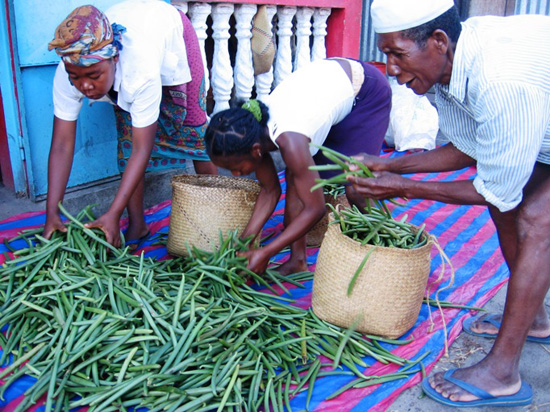
I'm amazed at how superior your vanilla is!
– Des, The Grommet

Tomato, Solanum lycopersicum, is related to the tamarillo, or tree tomato, as they are both part of the nightshade family, which includes eggplant, tobacco, potatoes, chile peppers and bella donna. The tomato originated as a small green fruit in the highlands of Peru, where it diversified. It then was either taken to Mexico during prehistoric times or tomatoes were also indigenous to Mexico; there is evidence that tomatoes were cultivated in Southern Mexico by 500 BC. Curiously, it doesn’t appear that the tomato was eaten in Peru before the Spanish Conquest.
The name “tomato” came from the Nahuatl “tomatl.” After the Conquest, the Spanish brought tomatoes to their colonies in the Caribbean. Tomatoes were taken to Europe, possibly with Colombus, possibly with Cortes; no one is certain. The Spanish took tomatoes to the Philippines, where they then were disbursed throughout Southeast Asia, then on through the rest of Asia.
Tomatoes easily adapted to the Mediterranean climate and were being cultivated there by the 1540s. For a long time, however, the fruit was considered unfit to eat in Great Britain and the American colonies and some people considered it poisonous. However, by the early 1700s it was accepted as a safe food to eat. It most likely arrived in the U.S. via the Caribbean.
To say that tomatoes are an international fruit is an understatement. One hundred and twenty-five million tons of tomatoes were produced, worldwide, in 2008. China is the largest producer, growing a quarter of the world’s commerical crop, followed by the U.S. and Turkey. California produces 90 percent of the processed tomatoes for the U.S. and about 35% of the international market.
Botanically, the tomato is considered a berry, a subset of fruit, but it is nutritionally classified as a vegetable. This is not an incompatible reference as “vegetable” is not a botanical name. There are now thousands of cultivars, ranging in size from very tiny cherry tomatoes up to beefsteak tomatoes that can weigh over a pound. (The largest tomato on record weighed 7 pounds 12 ounces and was grown in Edmund, Oklahoma.) Tomatoes and zucchini are the most commonly grown home crops. Increasingly, there is a demand for heirloom varieties that are far more flavorful and have a better texture than commercial varieties.
Tomatoes are high in the antioxidant lycopene. Cooking the tomatoes increases lycopene’s health properties. Certain genetic varieties of tomatoes are super fruits, with very high amounts of vitamins A and C, as well as lycopene, carotene, anthocyanin, and other antioxidants. Tomatoes are used in cuisine worldwide and eaten raw as well as cooked, in everything from soups to desserts and beverages.
Tomatillo, Physalis philadelphica, is also a vine related to the tomato and looks like a green tomato with a lantern-like paper husk around it. The fruits can be yellow, green, red or purple, and are used in Mexican and Central American cuisine. Tomatillo is a very acid fruit that is delicious when cooked into sauces.
I was given a small bottle of Rain’s Choice in a gift basket and I have been hooked ever since. The flavor makes all of my baking so much better! I will never use grocery store vanilla again!


© 2021. All Rights Reserved
Designed/Developed by Kat & Mouse